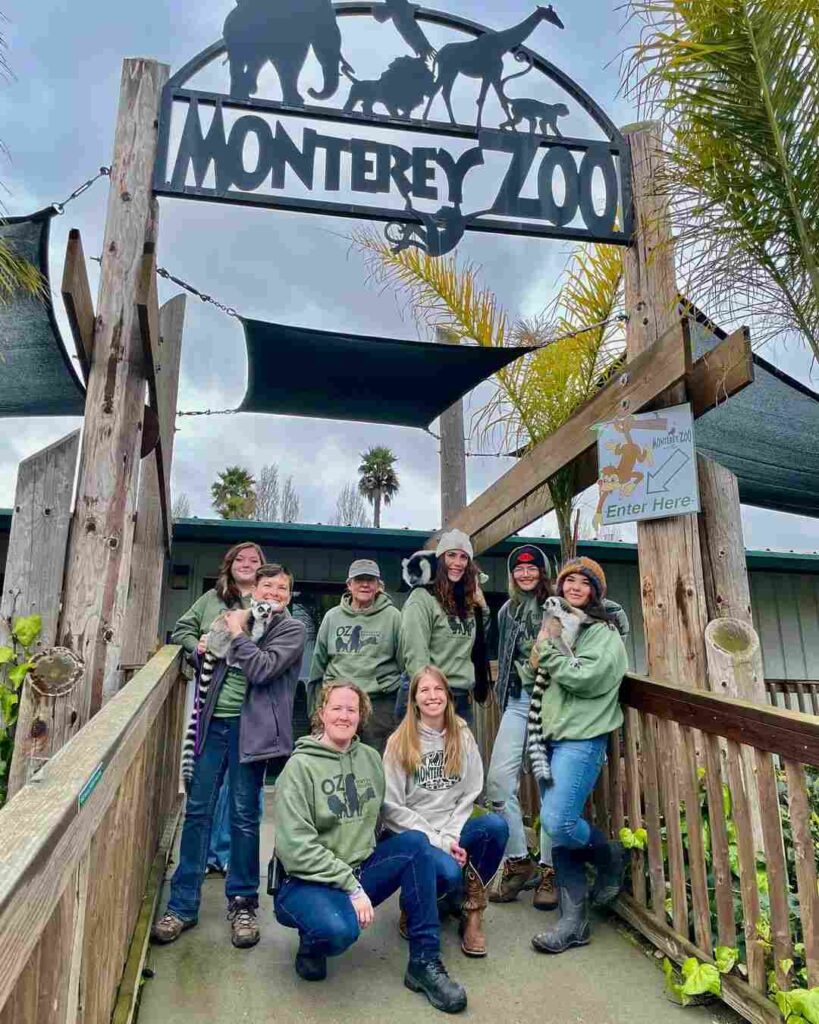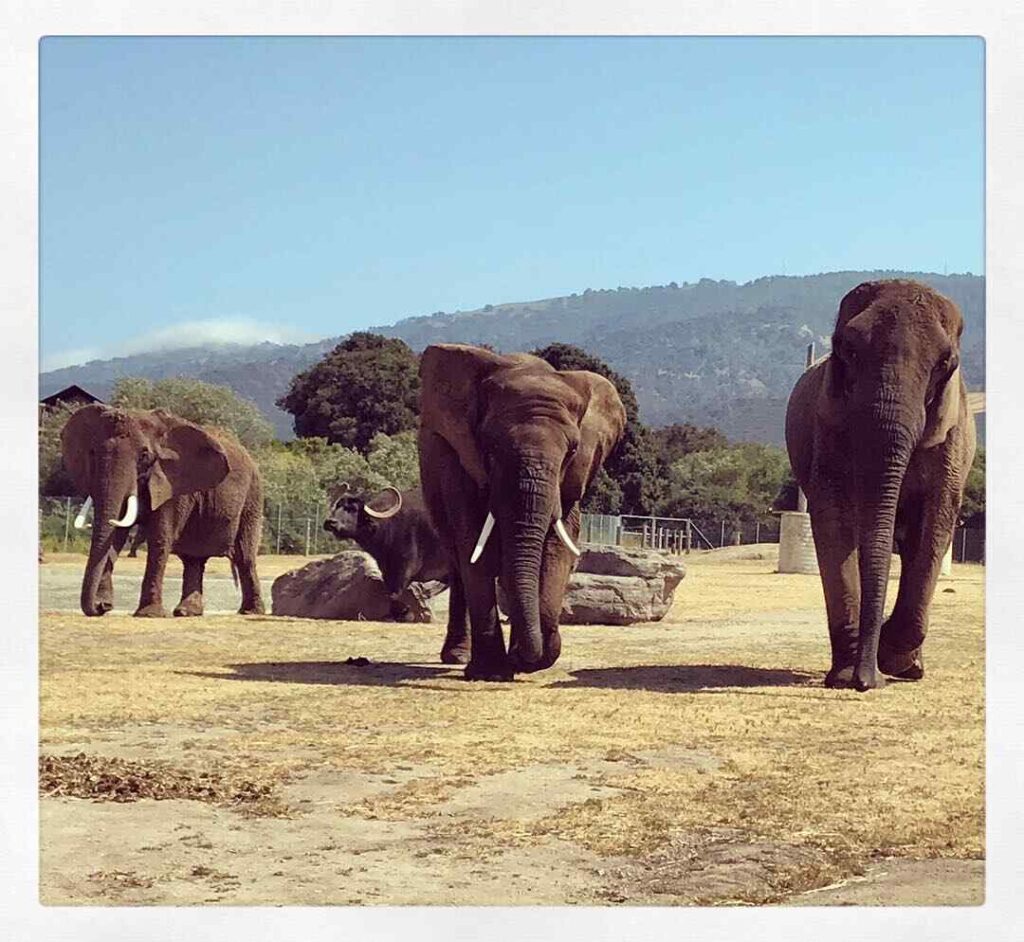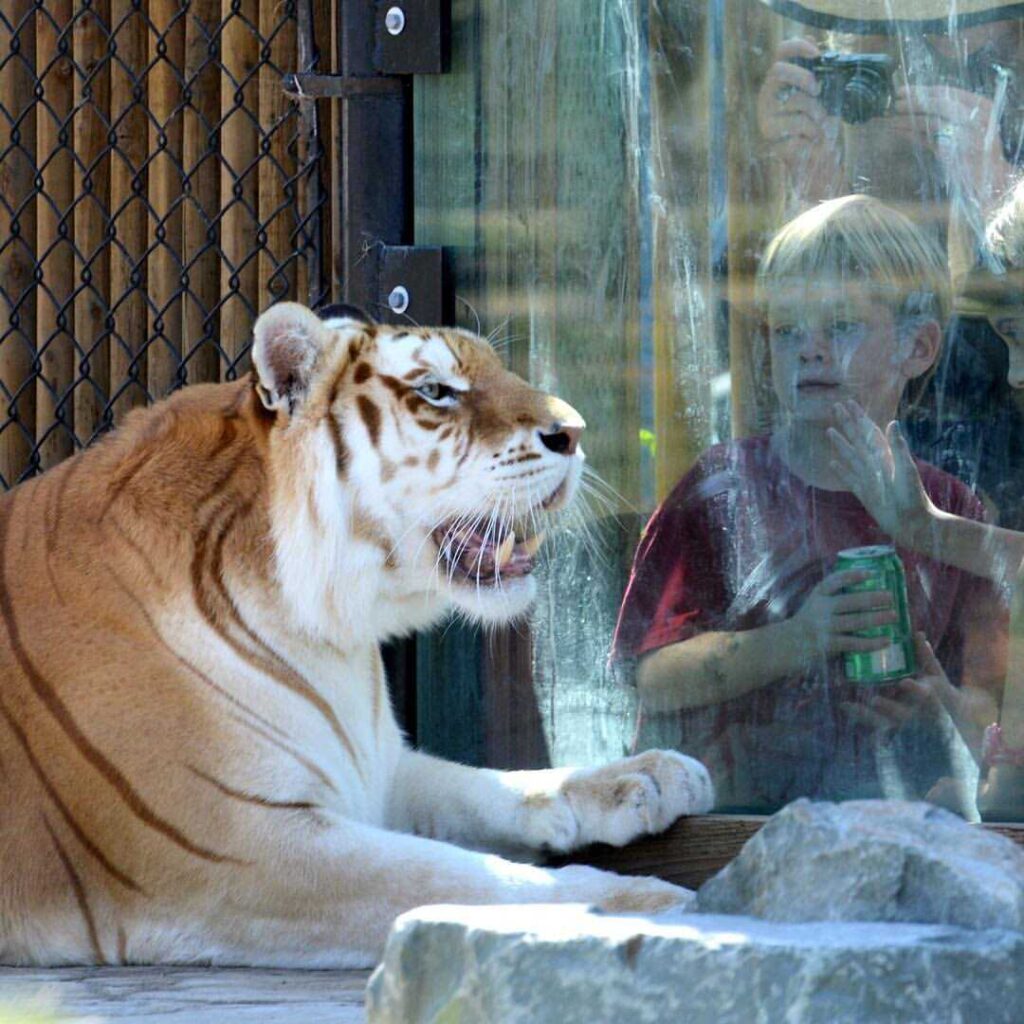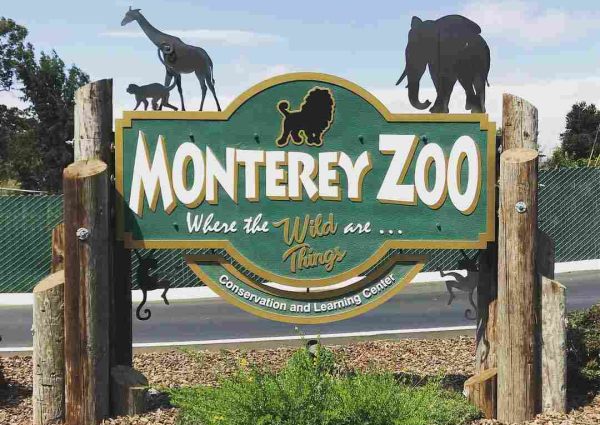Embarking on a journey to the Monterey Zoo is stepping into a world where wildlife thrives and education takes center stage. Nestled in the picturesque landscapes of Monterey County, this zoo is not just about observing animals; it’s an immersive experience that educates and inspires visitors of all ages. With over 100 species, the zoo serves as a sanctuary for creatures great and small, from the majesty of African elephants to the playful antics of Capuchin monkeys.
At the Monterey Zoo, it’s not just about seeing animals—it’s about connecting with them. Interactive programs like ‘Walk with the Rhinos’ or ‘Crunch Time’ offer visitors a firsthand look at the zoo’s conservation efforts, which stand at the forefront of its mission. The zoo prides itself on its educational programs, aiming to nurture a passion for wildlife in every guest.
Here, every encounter is designed to leave a lasting impression, whether it’s the roar of a lion that resonates in your memory or the gentle touch of an elephant that sparks a newfound appreciation for nature. With a commitment to providing the highest standard of care for its inhabitants, the Monterey Zoo has become a beacon of animal welfare and a testament to the power of conservation.
As you wander through the expansive habitats, the zoo unfolds as a series of discoveries—each animal’s story contributing to a larger narrative about our planet’s biodiversity. This is a place where education, conservation, and recreation intersect, creating a one-of-a-kind adventure that’s both heartwarming and enlightening. For families looking for an engaging day out, or individuals seeking a deeper understanding of our natural world, the Monterey Zoo promises a journey rich with wonder and learning.
Table of Contents
The Essence of Monterey Zoo
Founder’s Vision: Charlie Sammut
The Beginning: From Private Ownership to Public Joy
The inception of Monterey Zoo is a tale of passion transforming into purpose. Charlie Sammut, the zoo’s founder, began his journey with an affinity for animals that quickly evolved into a grand vision. A former law enforcement officer, Sammut’s life took a pivotal turn when he adopted an exotic pet, which planted the seed for what would become a beacon of animal advocacy.
His initial foray into the world of animal care started modestly, with personal responsibility for various animals. Over time, this commitment grew into the establishment of the zoo, a place where the community could share in the joy and wonder of the animal kingdom. This transition marked the transformation of a private collection into a public sanctuary that not only shelters animals but also ignites joy and curiosity in every visitor.
Zoo’s Evolution: Building a Community Legacy
The growth of the Monterey Zoo reflects a journey from a collection of animals to a community cornerstone dedicated to education and conservation. The zoo’s evolution was characterized by the expansion of both its physical footprint and its educational impact. With each passing year, the zoo has added new exhibits and programs, each echoing Sammut’s initial intent to foster a deep connection between humans and animals. By prioritizing the dissemination of knowledge and the protection of wildlife, the zoo has established itself as a community legacy, continually reinforcing the bond between nature and the people it serves.
Unique Experiences at Monterey Zoo
Full-Contact Animal Adventures
Monterey Zoo stands out for its full-contact animal adventures, offering visitors unparalleled interactive experiences. These encounters are carefully designed to educate the public about the natural behaviors and habitats of the animals while allowing for an up-close and personal connection that’s as thrilling as it is informative. Through these hands-on experiences, guests can engage with some of the zoo’s most fascinating residents, gaining insight into the importance of wildlife conservation and the zoo’s role in protecting animal welfare.
Accreditation and Recognition
The acclaim of the Monterey Zoo is solidified by its official accreditation, a testament to its excellence in animal care and public education. This recognition is not merely an accolade but a promise to visitors and the broader conservation community that the zoo adheres to the highest standards of animal welfare and educational outreach. It’s an acknowledgment of the zoo’s commitment to creating a haven for animals and an educational hub for humans, aligning with the best practices in zoological and conservation circles.

A Closer Look at the Inhabitants
The Monterey Zoo is renowned for its diverse array of animal exhibits that offer visitors a chance to experience the breadth of biodiversity. This section delves into the inhabitants of the zoo, from the majestic big cats to the intricate social structures of primates, and how these creatures play a vital role in the zoo’s education and conservation programs.
Diverse Animal Exhibits
From Big Cats to Birds
At the heart of the Monterey Zoo experience is the opportunity to witness the grandeur of big cats. Lions, tigers, and leopards are just a few of the zoo’s feline ambassadors for wildlife conservation. These animals are not just a thrilling sight for visitors but also a critical part of the ecosystem, often serving as indicator species for habitat health. Alongside the big cats, the zoo also boasts a variety of avian wonders, from the soaring eagles to the vibrant parrots. These birds offer a glimpse into the complexities of avian life and the importance of conservation efforts for these creatures that grace the skies.
The World of Primates
Primates, with their close genetic ties to humans, are always a focal point for visitors. The Monterey Zoo is home to a variety of these intriguing animals, from the intelligent capuchins to the stately baboons. Each species provides valuable insights into primate behavior and social dynamics, contributing to the zoo’s educational narrative. Understanding these species’ characteristics and natural habits enhances the visitor experience and underscores the zoo’s mission to educate the public on the importance of preserving these animals’ natural habitats.
Conservation and Education Through Wildlife
The Role of Lemurs and Capuchins
Lemurs and capuchin monkeys are more than just fascinating creatures to observe; they are integral to the Monterey Zoo‘s conservation and education initiatives. Lemurs, with their charismatic personalities and precarious status in the wild, serve as flagship species for the zoo’s efforts in conservation education. Capuchins, known for their remarkable problem-solving abilities, offer zoo-goers interactive experiences that highlight the intelligence of primates, fostering a deeper appreciation for these animals and the environmental challenges they face.
Baboons and Beyond: Engaging with African Wildlife
Baboons, part of the African wildlife contingent at the Monterey Zoo, offer a powerful connection to the African savannas. These animals, along with other African species at the zoo, are emblematic of the rich tapestry of life that inhabits the continent. Their presence in the zoo helps to educate visitors about the complex ecosystems of Africa and the critical need for conservation efforts to protect these environments. Through up-close encounters and educational talks, the zoo provides an immersive experience that brings the plight and beauty of African wildlife to the forefront of public attention.
In each exhibit, the Monterey Zoo ensures that the information is not only accurate and relevant but also accessible. Through careful curation and presentation of facts, figures, and stories, the zoo cultivates a learning environment that is both informative and engaging. It’s a delicate balance between entertainment and education, where visitors leave with a wealth of knowledge and a renewed commitment to wildlife conservation.

A Closer Look at the Inhabitants
The Monterey Zoo is renowned for its diverse array of animal exhibits that offer visitors a chance to experience the breadth of biodiversity. This section delves into the inhabitants of the zoo, from the majestic big cats to the intricate social structures of primates, and how these creatures play a vital role in the zoo’s education and conservation programs.
Diverse Animal Exhibits
From Big Cats to Birds
At the heart of the Monterey Zoo experience is the opportunity to witness the grandeur of big cats. Lions, tigers, and leopards are just a few of the zoo’s feline ambassadors for wildlife conservation. These animals are not just a thrilling sight for visitors but also a critical part of the ecosystem, often serving as indicator species for habitat health. Alongside the big cats, the zoo also boasts a variety of avian wonders, from the soaring eagles to the vibrant parrots. These birds offer a glimpse into the complexities of avian life and the importance of conservation efforts for these creatures that grace the skies.
The World of Primates
Primates, with their close genetic ties to humans, are always a focal point for visitors. The Monterey Zoo is home to a variety of these intriguing animals, from the intelligent capuchins to the stately baboons. Each species provides valuable insights into primate behavior and social dynamics, contributing to the zoo’s educational narrative. Understanding these species’ characteristics and natural habits enhances the visitor experience and underscores the zoo’s mission to educate the public on the importance of preserving these animals’ natural habitats.
Conservation and Education Through Wildlife
The Role of Lemurs and Capuchins
Lemurs and capuchin monkeys are more than just fascinating creatures to observe; they are integral to the Monterey Zoo‘s conservation and education initiatives. Lemurs, with their charismatic personalities and precarious status in the wild, serve as flagship species for the zoo’s efforts in conservation education. Capuchins, known for their remarkable problem-solving abilities, offer zoo-goers interactive experiences that highlight the intelligence of primates, fostering a deeper appreciation for these animals and the environmental challenges they face.
Baboons and Beyond: Engaging with African Wildlife
Baboons, part of the African wildlife contingent at the Monterey Zoo, offer a powerful connection to the African savannas. These animals, along with other African species at the zoo, are emblematic of the rich tapestry of life that inhabits the continent. Their presence in the zoo helps to educate visitors about the complex ecosystems of Africa and the critical need for conservation efforts to protect these environments. Through up-close encounters and educational talks, the zoo provides an immersive experience that brings the plight and beauty of African wildlife to the forefront of public attention.
In each exhibit, the Monterey Zoo ensures that the information is not only accurate and relevant but also accessible. Through careful curation and presentation of facts, figures, and stories, the zoo cultivates a learning environment that is both informative and engaging. It’s a delicate balance between entertainment and education, where visitors leave with a wealth of knowledge and a renewed commitment to wildlife conservation.

Educational Endeavors and Conservation Efforts
The Monterey Zoo is not just a place to see animals; it’s a living classroom and a conservation leader. Its educational programs and conservation initiatives are pivotal in fostering an understanding of wildlife and the environment among its visitors.
Learning and Engagement Programs
Safari Camps and Volunteer Opportunities
The Monterey Zoo offers a range of educational programs, including Safari Camps designed to immerse participants in wildlife learning experiences. These camps often combine fun activities with educational content, catering to a range of age groups. Additionally, the zoo provides numerous volunteer opportunities, allowing individuals to contribute to daily zoo operations and animal care. These programs are crucial for sparking interest in zoology and conservation careers, providing hands-on experience that is both rewarding and educational.
Internship and Training Programs
For those considering a career in animal care or zoo management, the Monterey Zoo offers internship and training programs. These programs are tailored to impart practical skills and in-depth knowledge about animal husbandry, veterinary care, and zoo operations. Interns at the zoo can expect to work alongside experienced professionals, gaining valuable insights that can only be learned in the field.
Pioneering Conservation Initiatives
Habitat Preservation and Species Protection
Conservation is a cornerstone of the Monterey Zoo‘s mission. The zoo’s habitat preservation efforts ensure that the animals enjoy environments that closely mimic their natural habitats. In addition to providing a more stimulating environment for the animals, these habitats educate the public about the importance of ecosystem diversity. The zoo also participates in various species protection programs, aiming to conserve biodiversity and protect endangered species through captive breeding programs and wildlife research.
Community Involvement in Conservation
The Monterey Zoo believes in the power of community involvement in conservation efforts. It engages the public through citizen science programs, conservation talks, and fundraising events for wildlife preservation. By involving the community, the zoo creates a broader base of support for its initiatives and educates the public on the importance of conservation, highlighting how individual actions can have a global impact.
Each program at the Monterey Zoo is designed to be accessible and informative, ensuring that visitors leave not just entertained, but also enlightened. Numbers and statistics related to conservation successes, animal care advancements, and educational program impacts are shared with the public to demonstrate the tangible benefits of the zoo’s efforts.

Planning Your Zoo Adventure
Planning your visit to the Monterey Zoo is the first step toward a day filled with wonder and discovery. This section provides essential information to help visitors make the most of their trip, including admission details, operating hours, tour packages, and unique zoo experiences.
Practical Information for Visitors
Admission Details and Operating Hours
Before you embark on your journey through the Monterey Zoo, it’s important to know the basics. The zoo typically opens its gates to the public at 10:00 AM and bids farewell to its last guests at 3:00 PM, allowing for a full day of animal adventures. Ticket prices are structured to accommodate everyone, from individuals to families, with annual passes offering a year’s worth of unlimited access. Special discounts are often provided to seniors, students, and military personnel, affirming the zoo’s commitment to community inclusion.
Tour Packages and Experiences
The Monterey Zoo offers a variety of tour packages to suit every interest and schedule. From guided tours providing in-depth information about the animals and their habitats to self-led tours that allow you to explore at your own pace, there’s something for everyone. Each tour is thoughtfully designed to ensure visitors leave with a deeper understanding of wildlife and the zoo’s role in conservation.
Enhancing Your Zoo Experience
Interactive Tour Highlights
For an even more memorable zoo visit, engage with interactive tours like ‘Walk with the Rhinos’ or ‘Crunch Time,’ where you can witness feeding time. These experiences are designed not just for entertainment but to educate and foster a connection between the animals and the visitors, highlighting the importance of each species and the zoo’s conservation efforts.
Technology Integration: QR-Codes and Mobile Apps
To enrich the educational experience, the Monterey Zoo harnesses technology such as QR-codes scattered throughout the zoo. By simply scanning a code with a smartphone, visitors can access a wealth of information about the animals they are viewing, including fun facts, conservation status, and details about the zoo’s care and research programs. Mobile apps may also be available to enhance your tour with interactive maps, schedules for shows and feedings, and even games for younger visitors.
All this information is provided to ensure that a day spent at the Monterey Zoo is not just enjoyable but also enlightening, inspiring a passion for wildlife and a commitment to conservation in all who visit.

Conclusion
In the heart of Monterey, the Monterey Zoo stands as a testament to the harmonious blend of education and conservation, bringing visitors face-to-face with the splendor of the animal kingdom. It’s a place where each corner turned is a new chapter in a story of conservation, a live exhibit where learning is interactive, and each animal is an ambassador to its species.
The zoo’s commitment to conservation is evident in every carefully crafted habitat and the passionate keepers who serve not just as caregivers but as educators. Here, knowledge is shared, curiosity is encouraged, and a love for wildlife is kindled. The educational programs, ranging from Safari Camps to volunteer opportunities, empower visitors of all ages to become stewards of the environment.
The Monterey Zoo is more than just a day visit; it’s a call to action—a chance to join a community that supports global conservation efforts while celebrating the beauty of wildlife. With an array of interactive tours, like the ‘Walk with the Rhinos’ and ‘Crunch Time’ feeding experiences, visitors gain an immersive understanding of what it takes to preserve our planet’s magnificent creatures.
Your visit, therefore, becomes a part of the zoo’s story—a story of hope, dedication, and the tireless pursuit of a future where humans live in harmony with nature. As the zoo continues to evolve, adding new experiences and expanding its conservation reach, it invites you to become a part of this journey. So, whether you’re marveling at the majesty of big cats or learning about the delicate balance of ecosystems, your presence supports the zoo’s mission.
We invite you to experience the wonders of the Monterey Zoo, to learn, to explore, and to be inspired. Each ticket purchased, each tour taken, and each donation made fuels the zoo’s ongoing commitment to the animals it houses and the wild they represent. Come for the wonder, stay for the cause, and leave with memories that will inspire a lifetime of appreciation for our natural world.
Frequently Asked Questions
The zoo is open from 10 AM to 5 PM daily, with last admission at 4 PM. Hours may vary during holidays and special events
Yes, the zoo offers a variety of educational programs for all ages, including school field trips, guided tours, and conservation workshops.
Absolutely, the zoo is fully accessible, offering wheelchair rentals and accessible pathways throughout the premises.
We welcome volunteers! There are many volunteer opportunities available, ranging from animal care to guest services.
Yes, there are multiple dining facilities within the zoo, offering a range of food and beverage options.

